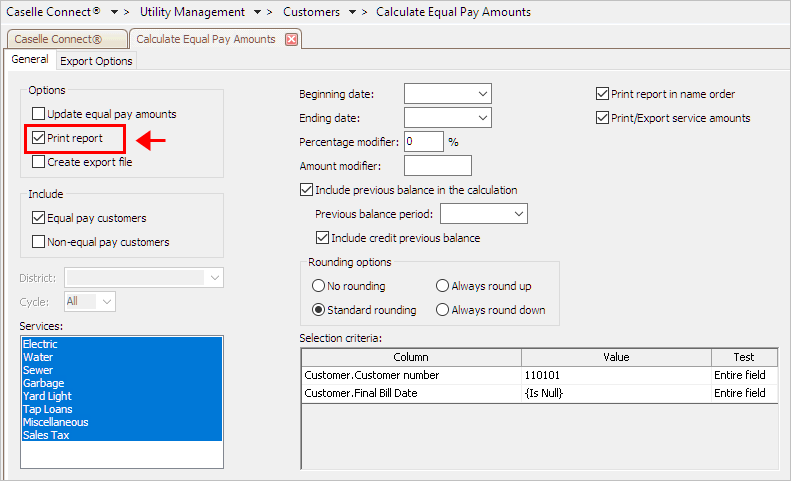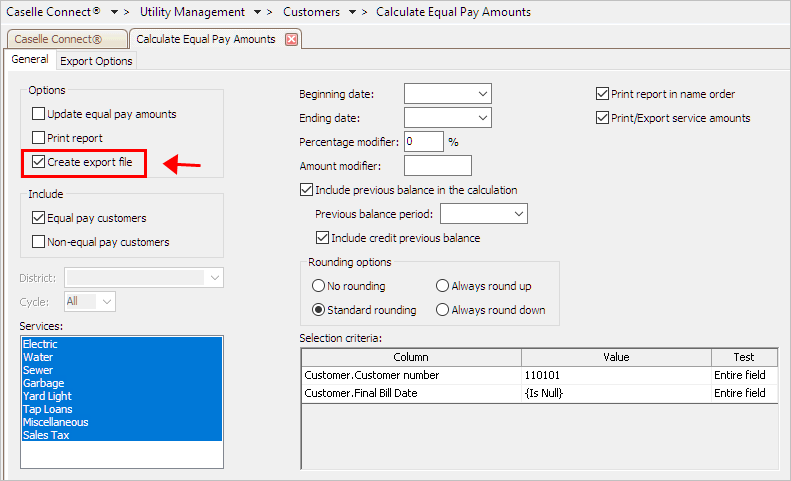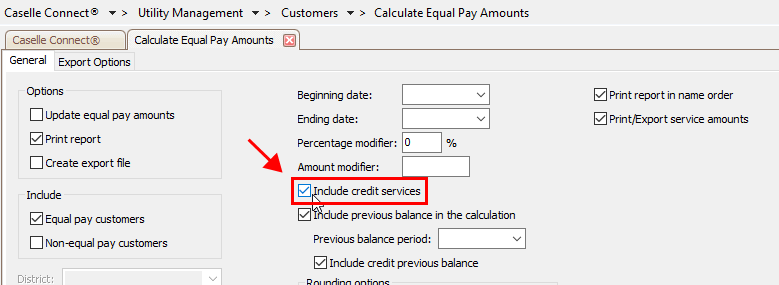How do I calculate equal pay amounts?
Calculate equal pay for a customer.
Equal pay is a payment option that averages power usage from the last twelve months and divides it into equal monthly payments. The calculated equal pay amount is saved in the billing record.
For example, this table shows the actual billed amounts for customer 1.101.1. The actual billed amounts vary each month based on the customer's usage. The customer prefers to pay the same amount each month in 2012.

Running the Calculate Equal Pay Amounts will total the actual amounts for 2011 and divide the total by twelve months to find the average amount to bill each month.
182 / 12 = 15.16666666666
City ABC does not round amounts, so the routine calculates 15.16 as the equal pay amount. The routine adds the remaining 8 cents to the last equal payment.
Contents
Watch a video
Learn what's new in the 2018.11 release (0m46s). Include credit services in the equal pay calculation.
Calculating equal pay amounts for review
Average usage from the last twelve months and divide it into equal monthly payments. Print the calculated equal pay amounts as a report to show me the equal pay amounts.
Do this...
1. Open Connect Utility Management > Customers > Calculate Equal Pay Amounts.
2. Select the checkbox titled Print Report.

Print Report checkbox
3. Do not select the checkbox titled Update Equal Pay Amounts.
4. Set up the options on the form to select the customers to include.
5. Click GO (CTRL+G).
The equal pay amount is calculated and prints on a report. No equal pay amounts are updated to customer records.
Updated 10Apr2018
Updating calculated equal pay amounts to customer
Update equal pay section for the selected service in the customer record with the calculated equal pay amount. This will replace the existing equal pay amount with a new equal pay amount.
Do this...
1. Open Connect Utility Management > Customers > Calculate Equal Pay Amounts.
2. Select the checkbox titled Update Equal Pay Amounts.

Update Equal Pay Amounts checkbox
3. Set up the options on the form to select the customers to include.
5. Click GO (CTRL+G).
The equal pay amount is calculated and updated to the customer record.
Updated 10Apr2018
Exporting equal pay amounts
Calculate equal pay amounts and save them to an export file.
Do this...
1. Open Connect Utility Management > Customers > Calculate Equal Pay Amounts.
2. Select the checkbox titled Create Export File.
Do not select the checkbox titled Update Equal Pay Amounts unless you want to update the new equal pay amounts to customer records.

Create Export File checkbox
3. Set up the options on the form to select the customers to include.
4. Click to select the Export Options tab.

Export Options tab
5. Enter the export file name, character to surround text fields, and choose the field delimiter.

Export Options
6. Click GO (CTRL+G).
The equal pay amount is calculated and saved to an export file. No equal pay amounts are updated to customer records.
Updated 10Apr2018
Including credit services in the equal pay calculation
Also known as budget billing. For example, City XYZ has discounts to bill, military discount that's billed as a credit service.
Do this...
1. Open Connect Utility Management > Customers > Calculate Equal Pay Amounts.
2. Set up the options as usual.
3. Click to select the checkbox titled Include Credit Services.

Include credit services
4. Click GO (CTRL+G).
The equal pay amount includes credit service balances.
Updated 21Aug2018
Options
Amount modifier
An amount modifier is a variable that adjusts the calculated amount by adding or subtracting an amount.
Do you want to use an amount to adjust the equal pay amount?
Yes, I want to add/subtract an amount. Use the Amount Modifier field to enter an amount. Enter the amount as is to add it to the calculated amount. Enter the amount followed by a minus sign to subtract it from the calculated amount.
No, I do not want to add/subtract an amount. Use the Amount Modifier field to enter a zero (0).
Beginning/ending date
Use the Beginning/Ending Date to define the date range. Only transactions with transaction dates that occur within the date range will be included. Use the Beginning Date field to enter the first date in the date range. Then, use the Ending Date field to enter the last date in the date range.
Cycle
A cycle is an interval of time during which utilities are billed.
Are you using cycles?
Yes, I am using cycles. Select a cycle name from the Cycle field. The routine will apply deposits/interest to the selected cycle.
No, I am not using cycles. Continue to the next step.
District
A district is an area, region, or section for billing utilities.
Are you using districts?
Yes, I am using districts. Select a district name from the District field. The routine will apply deposits/interest to the selected district.
No, I am not using districts. Continue to the next step.
Include
An equal pay customer is a customer that is billed an equal amount each month based on annual usage. A non-equal pay customer is any customer that is billed based on usage.
What do you want to do?
I want to calculate equal pay for equal pay customers. Click to select Equal Pay Customers.
I want to calculate equal pay for customers that are billed based on usage. Click to select Non-equal Pay Customers.
Include credit previous balance
A credit previous balance occurs when an account is overpaid in the previous period.
Do you want to include customers with a credit balance in the previous period?
Yes, include customers with a credit balance in the previous period. Click to select Include Credit Previous Balance.
No, do not include customers with a credit balance in the previous period. Click to deselect Include Credit Previous Balance.
Include previous balance in the calculation
A previous balance occurs when a customer has a balance remaining from the previous period. Use Include Previous Balance in the Calculation to add the previous balance to the current balance to calculate the equal payment amount.
Previous Customer Balance + Current Customer Balance = Equal Payment Total Amount
Do you want to include a previous balance to the calculation?
Yes, I want to include a previous balance. Click to select Include Previous Balance in the Calculation. Then, use the Previous Balance Period field to select the period that contains the previous balance.
No, I do not want to include a previous balance. Click to deselect Include Previous Balance in the Calculation.
Options
Use options to select the transactions or reports this routine will create for you. Update equal pay amounts will calculate the equal pay amount and copy the calculated amount to the customer's billing record.
Print report will calculate the equal pay amount and print a report of the calculated amounts. This option will not save the calculated amount or copy the calculated amount to the customer's billing record.
Create export file will calculate the equal pay amount and save the calculated amounts as a .txt file that you can import into a third-party application. This option will copy the calculated amount to the customer's billing record.
What do you want to do?
I want to copy equal pay amounts to customer billing records. Click to select Update Equal Pay Amounts.
I want to print a report that shows the calculated equal pay amounts without updating the calculated amount to customer records. Click to select Print Report.
I want to create an export file for the calculated equal pay amounts and copy the calculated amount to the customer's billing record. Click to select Create Export File.
Percentage modifier
A percentage modifier is a variable that adjusts the calculated amount by multiplying the calculated amount by part of a whole expressed in hundredths, and then adding or subtracting the percentage to the calculated amount.
New Calculated Amount = Calculated Amount - [Calculated Amount x Percentage Modifier]
Do you want to use a percentage to adjust the equal pay amount?
Yes, I want to add/subtract a percentage. Use the Percentage Modifier field to enter value expressed in hundredths. Example: 0.25 represents 25%. To subtract the percentage, key the minus sign (-) followed by the percentage.
No, I do not want to add/subtract a percentage. Use the Percentage Modifier field to enter a zero (0).
Previous balance period
The Previous Balance Period is the portion of time when the previous balance is recorded.
What is the period with the previous balance?
Use the Previous Balance Period field to select the period that contains the previous balance.
Print/export service amounts
A service amount is the outstanding balance on a customer's account that covers the cost of providing the service. If the option to Print Report is selected, this option will print the service amount on the report. Likewise, if the option to Create Export file is selected, this option will add the service amount to the saved file.
What do you want to do?
I want to include service amounts on the printed report/export file. Click to select Print/export service amounts.
I do not want to include service amounts in the printed report/export file. Click to deselect Print/export service amounts.
Print report in name order
You can decide how to display information in the report/export file. Use Print Report in Name Order to sort the equal pay amounts by customer name instead of customer number.
What do you want to do?
I want to sort equal pay amounts by customer name. Click to select Print Report in Name Order.
I want to sort equal pay amounts by customer number. Click to deselect Print Report in Name Order.
Rounding options
Rounding means replacing a numerical value with another value that is approximately equal to the original number. For example, rounding $24.667 up to $24.67.
Use Standard Rounding to round up when the value is greater or equal to 0.5, and round down when the value is less than 0.5. Example: 1.667 rounds up to 1.67, while 1.664 rounds down to 1.66.
Use Always Round Up to round up to the next whole dollar. Example: 1.667 rounds up to 2.
Use Always Round Down to round down the next whole dollar. Example: 1.667 rounds down to 1.
Use No Rounding to leave the value as is. Example: 1.667 is recorded as 1.66.
What do you want to do?
I want to use standard rounding. Click Standard Rounding.
I want to round amounts up to the next whole number. Click Always Round Up.
I want to round amounts down to the next whole number. Click Always Round Down.
I do NOT want to round amounts. Click No Rounding.
Services
Use the Selected Service list on the Services tab to select the service, or services, that the routine will use the selected services to calculate a total.
What do you want to do?
I want to include all services. On the Services tab, click to select Include All Services.
I want to select the services to include. On the Services tab, click to deselect Include All Services. Click the Select button. Use the Selection form to move the service to the Selected Services list. Click OK.
Troubleshooting
How do I set up equal pay so I can enter an amount on only one service instead of allowing the system allocate the amount to all services? How do I increase the amount allocated to one service?
1. Open Connect Utility Management > Customers > Modify Existing Customers. Go to the Services tab and click on the Service 2 tab. Use the Amount field in the Equal Pay area to enter the equal pay amount manually. You will not be able to enter the calculated date on this tab.
2. Go to the Customer 2 tab. Enter the date the equal pay amount was entered in the Calculate Date field in the Equal Pay area.
Copyright © 2025 Caselle, Incorporated. All rights reserved.